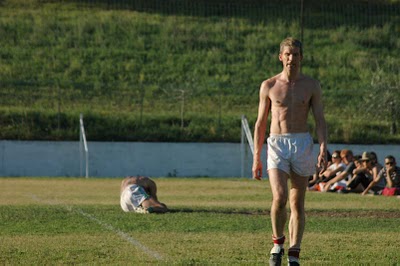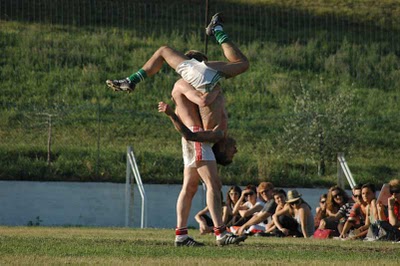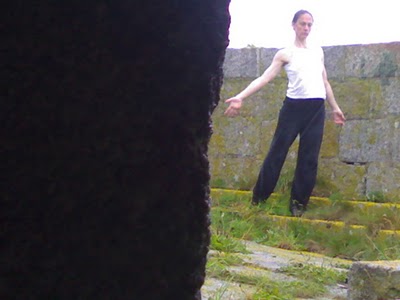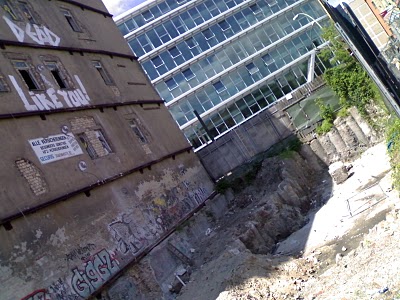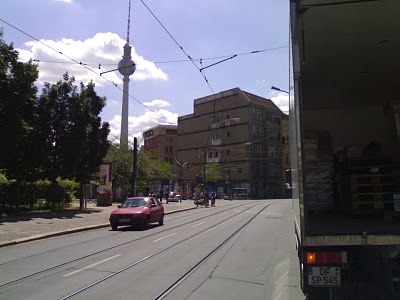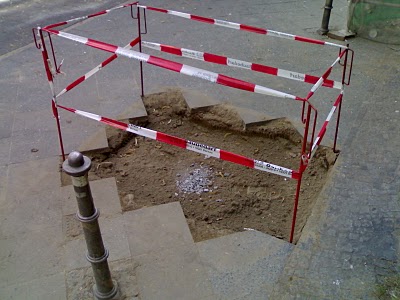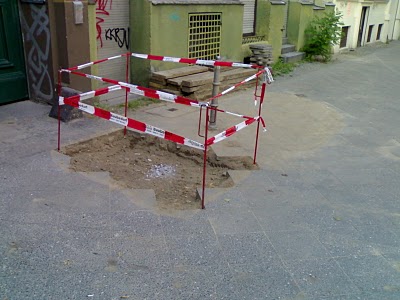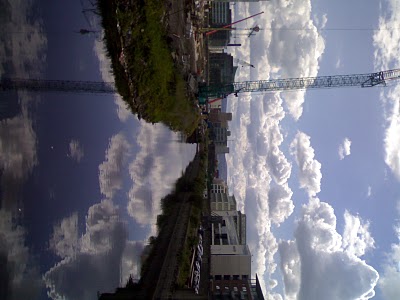We did go behind the protective/prohibitive barriers to do this perching sequence and a security guard came to warn us of the exposed power cables, but when I said we were dancing he left us alone.
Yearly Archives: 2007
Match in Bassano
Performing on a soccer pitch in Bassano is kind of stretch of the bodies and buildings concept. However the idea of bringing dance outside of its protective glasshouse to be tested in a public space links the research and manifestation of this project. The performance in Bassano was at the invitation of the Roberto Casarotto who curated the B-Motion Festival as part of the Operaestate Festival in the region. I was excited to participate and to attend because much of the work he has assembled i by independent artists and its reassuring to see the possibilities for such work to reach a wider audience without compromising its idiosyncrasy.
For Matthew and me, the challenge was to deal with the huge space which the football pitch presented. I took the material from the film and extended it from one goal post to the other. Sunshine and the sandy ground made it an effort but that effort is already part of the truth of the material and didn’t need to be denied. Performing in that kind of public space where the work isn’t sealed off from outside influence requires a particularly sturdy kind of piece but it brings with it a potential for beautiful additions: we gained the shouts of elderly gentlemen playing boules and the voices of a gospel choir practising nearby. One cannot rely on these chance additions but one can be grateful for them and for serendipity.
There’s an interview and more photos on the b-motion blog – a great idea that records and deepens the festival experience:
http://www.bmotion.splinder.com/tag/fearghous_oconchuir
Martello Towers
I’ve spent the past four days taking boats, wading through water, tromping through fields and climbing ropes so that I could dance on top of some of the twelve Martello Towers which were built in what is now Fingal, north of Dublin. The adventure is part of a Public art commission by Fingal County Council, for which I am collaborating with multi-disciplinary artist, Dan Dubowitz. We’re hoping to re-establish a tentative connection between the towers which were built to protect against Napoleonic invasion. However the towers never had to defend the coastline and have since been adapted to various uses (museum, private dwelling, store house) or allowed to fall to ruin. Of course, in falling to ruin, the towers have continued to serve various functions – as shelter, as haven for drinkers and lovers, as a place for pigeons to roost and for hardy plants to colonise. Now there somewhere for a physical and imaginative exploration of bodies and this particular set of buildings.
The adventure aspect of this project is fun: I love scaling the towers and negotiating the tricky entry to them. This experience is more than fun though: it’s also a physical experience which colours the movement -material I bring to the top of the towers. If I were butchered there, adrenaline would make my flesh taste different. Dan has set up a rotating camera to capture the activity on top of the tower, or to catch glimpses of the material at least. The constant rotation means that much material is missed from the shot. There is a pathos in the absence and presence.
It’s not just me on the towers: Bernadette Iglich joined us for the adventure, finding a way to feed the challenges of the environment and weather into the life blood of her movement. Her DNA is now imprinted on the towers and it has left its marks on her
You Tube and the US Presidential election
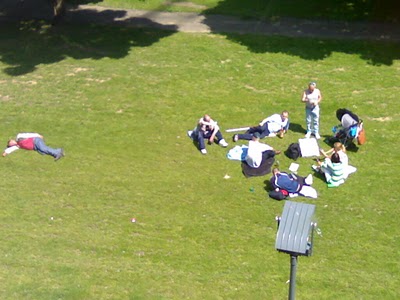
An article in today’s Observer (http://observer.guardian.co.uk/review/story/0,,2121069,00.html) describes the impact of You Tube and its user-generated content on the US Presidential election campaign.
“The notion of a ‘citizen ad’ is an intriguing one, suggesting as it does both a citizen’s arrest – the idea of doing something without pay for the public good – and Citizen Kane. You can, from the privacy (and affordability) of your own home, have an effect akin to that of a mogul. Professor Kathleen Hall Jamieson, director of the Annenberg Public Policy Centre at the University of Pennsylvania, and one of the country’s leading experts on advertising in political campaigns, considers this development and says: ‘There’s a saying in the United States, “The press is free for anyone who owns one.” That’s no longer true. You still have to have some income, because you have to have a computer, but the cost of getting access to the public has dropped dramatically – and that goes back to the early days of the republic, when there was more capacity to simply post things. The American revolution was fed by individuals who could easily get things into circulation, in part because the public was so small. When we moved to mass channels of communication, the ability of the individual to affect politics dropped, and to some extent that’s been regained now. It changes the rules, and I think it’s healthy.'”
I am excited about the freedom and diversity of expression this citizen action allowed and self- flatteringly imagine my own work to be of a piece with the ethics and method of such citizen action. My dances in unexpected places, shared with whoever see them, live or in this blog, are intended to be a kind of permission to wider freedom, a suggestion of more possibilities than are usually explored.
But a quotation from Phil de Vellis who made one particularly noteworthy pro-Obama video that made me ask myself about my own commitment to engaging the public: “you have to actually interact with your audience out there, and a pretend conversation is not enough”.
Safe Pass Training
“The FAS ‘Safe Pass’ Health and Safety Awareness Training Programme is a one day safety awareness training programme aimed at all construction site personnel, including new entrants, to ensure that they have a basic knowledge of health and safety. It is important that workers have a basic knowledge of health and safety to make them aware of the inherent dangers on construction sites so that they will not be a risk to themselves or to their co-workers who work alongside them.”
Sitting alongside Dublin City Council employees (planners, storemen, designers, cleansing team) I wondered what I was really doing there. I was tickled to be taking the course and enjoyed the incongruity and the chance to bring my work into an environment that didn’t expect it. But what was I really going to gain.
The training modules incorporated within the safe pass programme are:
– The reasons for promoting safety
– Health and Safety at Work Legislation
– Accident reporting & Emergency procedures
– Accident prevention
– Health and Hygiene
– Manual Handling
– Working at heights
– Working with Electricity, underground and overhead services
– Use of hand held equipment
– Safe use of vehicles
– Noise and vibrations
– Excavations and Confined Spaces”
So I sat there and took in the sensible information (we didn’t get to Weill’s disease until near the end and as someone acquainted with pigeon droppings my ears pricked up) while simulataneously letting some other part of my brain take that information and examine it from other perspectives.
I imagined dancing on hydraulic platforms (working at heights), burrowing in excavations and confined spaces, with a whole lot of manual handling going on.
Ernest Pignon-Ernest
Adrian ( www.gai-savoir.net) has drawn my attention to this work of Ernest Pignon-Ernest who makes interventions in the public space with beautiful trompe l’oeil drawings of human bodies. He affixes the drawings to buildings and leaves them to weather. I understand that he takes account of the particularity of each environment and draws his work accordingly. He does make the work in the studio though and only when it’s ready abandons it in the public space.
I ask myself how much I want to make material that takes the particular built environment into account. I’m wary of accommodating external pressures too soon in the process as what interests me is the encounter between the prepared material and the environment. Of course there’s accommodation in that encounter but the material has an independence that precedes the encounter.
There’s more information on Pignon-Ernest in this blog:
http://espace-holbein.over-blog.org/archive-10-05-2006.html
EastBerlin Flap
Near the EastSide Gallery in Berlin, I found this open space to do my flip-flop flap dance. Something about Berlin (the background dope scent?) made me want to do silly, irreverent movement though the music with this clip pulls it back to a more sombre tone. I’d expected to find Berlin a good environment for my bodies and buildings research since it has undergone so much change in the years since reunification but I found the atmosphere different. The building is reconstruction more than construction; the city and its people seem familiar with the large projects around them. This current wave of building is one of many Berlin has experienced. And so there is less dissonance between the bodies and the building around.
In Ireland, where the huge building programme is unprecedented, the challenge of working out the relationship between what was before and what is now, between what our bodies remember and what these new structures dictate, is more compelling for me.
Wounds or graves
Working in Berlin this week, I responded again to the similarity of building sites to open graves in the city. ‘Dead like you’ – the graffiti on the building on the corner of Rosenthalerstrasse underlined the connection though I’m not sure what its point is. I think of it as a kind of memento mori.
This little grave in Kreutzberg is a gentler reminder of transience. The red tape marks the boundaries and signals danger. The collection of flint in the centre of the hole gives it a shrine-like quality, or a sense of an ancient tomb uncovered. In my head anyway…
Our ‘green’ Taoiseach
Thanks to Fintan O’Toole Irish Times article about Bertie Ahern this weekend (Sat, Jun16)(http://www.ireland.com/newspaper/newsfeatures/2007/0616/1181771177107.html), I have a readymade link between urban construction, destruction, Ireland and China.
‘No Irish political leader has ever been so openly contemptuous of environmental concerns. This is the Taoiseach, after all, who complained in 2003 that every big infrastructural project has to “go through eight hoops, through all environmental, planning and blah blah blah, and every blah costs a few hundred million”. This is the Taoiseach who loftily dismissed all objections to motorway routes as being about “swans, snails and people hanging out of trees”, and who sighed with envy in Shanghai at the power of a Chinese mayor to bulldoze everything in his way: “Naturally enough I would like to have the power of the mayor that when he decides he wants to do a highway and, if he wants to bypass an area, he just goes straight up and over”.’
Perhaps I can be one of the people hanging from trees, or a swan, or a snail – a brake on untrammeled bulldozing for the physical life that the Taoiseach’s list of irritating objections embodies.
Bulldozer, snail, swan, hanging body – power.
The Black Book
Looking at the Grand Canal Theatre video material, I remembered images from Orhan Pamuk’s The Black Book. It’s a kind of detective novel set in Istanbul but the novel is as much about the city and its expression of Turkish identity as it is about the narrator’s missing wife. It’s a difficult read; it is labyrinthine in its structure like Foucault’s Pendulum. But I recall clearly the dark spaces of the city he describes: the tunnels and caves beneath Istanbul which catalogue its history and contain a fantastical alternative version of the present; the dark central shaft of the apartment building where the narrator’s family live, a shaft where items lost and fallen gather. These dark spaces are a kind of unconscious – a space made of memory, fantasy and desire – what was and what mustn’t be. We build in the light but but can’t avoid dealing with these shadow spaces

